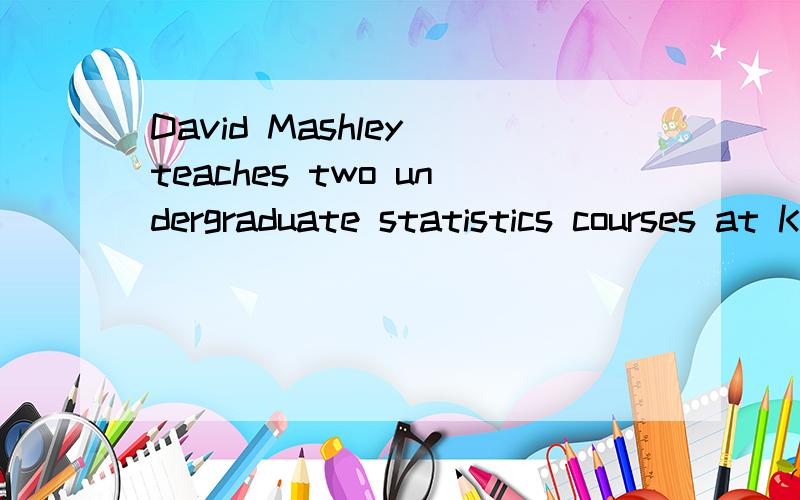David Mashley teaches two undergraduate statistics courses at Kansas College.The class for Statistics 201 consists of 7 sophomores and 3 juniors.The more advanced course,Statistics 301,has 2 sophomores and 8 juniors enrolled.As an example of a busine
来源:学生作业帮助网 编辑:作业帮 时间:2024/04/28 19:25:27

David Mashley teaches two undergraduate statistics courses at Kansas College.The class for Statistics 201 consists of 7 sophomores and 3 juniors.The more advanced course,Statistics 301,has 2 sophomores and 8 juniors enrolled.As an example of a busine
David Mashley teaches two undergraduate statistics courses at Kansas College.The class for Statistics 201 consists of 7 sophomores and 3 juniors.The more advanced course,Statistics 301,has 2 sophomores and 8 juniors enrolled.As an example of a business sampling technique,professor Mashley randomly selects,from the stack of Statistics 201 registration card,the class card of one student and then places that card back in the stack.If that student was a sophomore,Mashley draws another card from the Statistics 201 stack; if not,he randomly draws a card from the statistics 301 group.Are these two draws independent events?What is the probability of:
a) A junior's name on the first draw?
b) A junior's name on the second draw,given that a sophomore's name was drawn first?
c) A junior's name on the second draw,given that a junior's name was drawn first?
d) A sophomore's name on the both draws?
e) A junior's name on the both draws?
f) One sophomore's name and one junior's name on the two draws,regardless of order drawn?
David Mashley teaches two undergraduate statistics courses at Kansas College.The class for Statistics 201 consists of 7 sophomores and 3 juniors.The more advanced course,Statistics 301,has 2 sophomores and 8 juniors enrolled.As an example of a busine
a) 3/(3+7)=3/10
b)junior's name on the second draw : 7/10×3/10+3/10×8/10=9/20
junior's name on the second draw and a sophomore's name was drawn first:7/10×3/10=21/100
(21/100)/(9/20)=7/15
c) junior's name on the second draw : 7/10×3/10+3/10×8/10=9/20
A junior's name on the second draw and a junior's name was drawn first: 3/10×8/10=6/25
(6/25)/(9/20)=8/15
d)7/10×7/10=49/100
e) 3/10×8/10=6/25
f) 7/10×3/10+3/10×2/10=27/100
PS:楼上的你given 没有翻译.而且是大二生不是高中生.
嘿嘿本人英语好,但数学可是一塌糊涂。 让我来翻译吧! 其实这道题目就是个可能性- - 。 david 叫两个还没毕业的班级。班级201要7个高中生和3个初中生。另个班级,更为优秀(算是尖子班) 班级301要有2个高中生和8个初中生。所以呢他要从抽取201班级的学生,要随意抽一张学生的卡又放回去。如果那个学生是个高中生,david就又要从201的抽箱中抽1位,但如果那学生不是高中生,那么david就...
全部展开
嘿嘿本人英语好,但数学可是一塌糊涂。 让我来翻译吧! 其实这道题目就是个可能性- - 。 david 叫两个还没毕业的班级。班级201要7个高中生和3个初中生。另个班级,更为优秀(算是尖子班) 班级301要有2个高中生和8个初中生。所以呢他要从抽取201班级的学生,要随意抽一张学生的卡又放回去。如果那个学生是个高中生,david就又要从201的抽箱中抽1位,但如果那学生不是高中生,那么david就要从301箱中随意抽选一位。问:这两个抽选的概率相等吗?以下问题是问你每个的可能性。
a) 第一次抽到的是个初中生
b)第二次抽到的是个初中生,第一次抽到的是高中生。
c) 第二次抽到的是个初中生,第一次抽到的也是初中生
d) 两次抽到的都是同一个高中生
e)两次抽到的都是同一个初中生
f) 不确定,sorry。
收起
you did not say that "7 sophomores and 3 juniors"和"2 sophomores and 8 juniors enrolled"的card 数量是否一样,所以我感觉你是否少说了什么条件。或者说the two events are independent completely .They are not related at all.
晕哈,哥们不是我不帮你,中文的我解,但英语藕看不懂